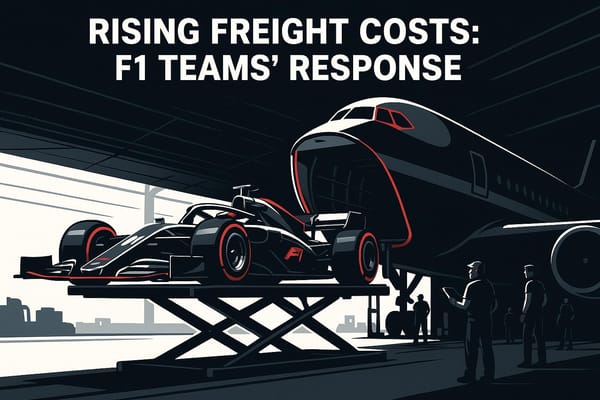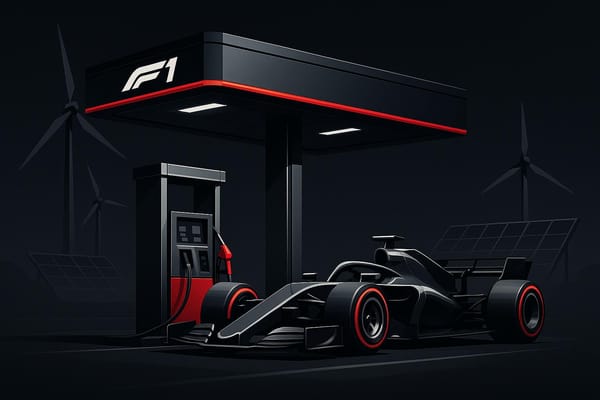5 Mind-Blowing Facts About F1 Transmission You Didn't Know
Explore the revolutionary innovations in F1 transmissions, from lightning-fast shifts to carbon fiber construction, shaping both racing and road cars.

Formula 1 transmissions are engineering marvels that combine speed, precision, and innovation. Here’s a quick dive into the most impressive facts:
- Lightning-Fast Shifts: F1 gearboxes can shift gears in as little as 2–3 milliseconds, saving up to 0.3 seconds per lap.
- Semi-Automatic Revolution: Introduced by Ferrari in 1989, semi-automatic gearboxes cut shift times from 200 milliseconds to just 30–50 milliseconds and improved reliability.
- Seamless Gear Changes: Dual-gear engagement technology ensures uninterrupted power delivery, enhancing control and reducing tire wear.
- Ultra-Lightweight Design: Carbon fiber gearboxes weigh under 88 pounds, offering incredible strength while improving performance.
- From Track to Road: Innovations like paddle shifters, first used in F1, are now standard in many modern cars.
These advancements not only dominate the racetrack but also shape the future of everyday driving.
| Feature | F1 Transmission | Impact on Road Cars |
|---|---|---|
| Shift Speed | 2–3 milliseconds | Faster dual-clutch systems |
| Material | Carbon fiber | Lightweight performance vehicles |
| Gear Change System | Paddle shifters | Standard in premium cars |
| Power Delivery | Seamless (continuous) | Smoother driving experience |
F1 transmissions are a perfect example of how motorsport innovation drives progress in automotive technology.
What's Inside an F1 Gearbox (& How it Works) | F1 Engineering
1. The Rise of Semi-Automatic Gearboxes
When Ferrari introduced the semi-automatic gearbox in the 1989 Ferrari 640, it marked a turning point in Formula 1 racing history. This game-changing technology had its origins in earlier experiments that laid the groundwork for its development.
Back in 1979, Ferrari engineer Mauro Forghieri tested a prototype in the 312 T, using a high-pressure hydraulic system paired with buttons mounted on the steering wheel. Gilles Villeneuve, after completing 100 laps with the system, remarked, "A steel shift lever will always be more reliable than electronics".
The project gained momentum again in 1986 under John Barnard, who saw its potential with the shift to naturally aspirated engines. These engines had narrower power bands, making precise and efficient gear changes critical for performance. The semi-automatic gearbox delivered a massive improvement: gear shifts now took just 30–50 milliseconds compared to the 200–250 milliseconds required for manual transmissions.
"There are several advantages to the semi-automatic gearbox. First, the driver gets to keep both hands on the wheel, so it's easier for him to get the maximum from the car – particularly through fast corners, when the steering gets very heavy. Second, you can change gear in 30–50 milliseconds as opposed to 200–250 milliseconds, so it's significantly faster."
– Patrick Head, Director of Engineering, Williams F1
With drivers making over 3,800 gear changes during a typical two-hour race, the new system not only boosted speed but also reliability. Patrick Head explained its impact further: "But we decided to keep semi-auto 'boxes because 95 percent of engine failures in the old days were caused by a driver changing down too early and over-revving the engine. The moment you have gear-shifting under electronic control, over-revved engines are out the door and life is much cheaper!".
The new technology proved its worth immediately. Nigel Mansell secured victory in his debut race for Ferrari in 1989, using the 640's revolutionary paddle shift system. By the mid-1990s, every F1 team had adopted sequential semi-automatic gearboxes, solidifying their place in the sport's history. Beyond the racetrack, this innovation made its way into road cars, with Ferrari introducing paddle shifters in their F355 F1 model in 1997.
2. Dual-Gear Engagement Technology
One standout feature in Formula 1 engineering is the seamless shift system, introduced under FIA regulations in 2005. This system allows the next gear to engage before the current one is fully disengaged, enabling gear changes in just 2–3 milliseconds. This not only reduces drive loss but also trims up to 0.3 seconds off each lap - a game-changer for acceleration and overall performance.
Switching gears at such speeds generates torque peaks up to 10 times the static torque, requiring exceptional precision and advanced electronic controls. Remarkably, this is achieved with a minimal weight addition of just 3.3 pounds (1.5 kg).
The system also uses the ECU to track each gear's position, compensating for barrel shaft flexing to ensure optimal shifts. Beyond its technical brilliance, the seamless shift system minimizes power loss - a benefit noted by MotoGP champion Jorge Lorenzo, who shared his experience:
"When I tried it in Brno I was smiling because it was nice not to feel this drop in power. With a normal gearbox the bike moves every time you shift; with the seamless you can't feel it, it should save tires and also you're more in control".
Here's how the seamless gearbox compares to a traditional one:
| Aspect | Traditional Gearbox | Seamless Gearbox |
|---|---|---|
| Shift Time | Slower shifts with power interruption | 2–3 milliseconds with continuous power |
| Power Delivery | Interrupts during gear changes | Maintains constant power flow |
| Vehicle Stability | Noticeable movement during shifts | Smoother operation, better control |
| Tire Wear | Higher due to abrupt power loss | Reduced thanks to consistent power flow |
| Lap Time Impact | Baseline | Up to 0.3 seconds faster per lap |
This system is a testament to F1's relentless pursuit of efficiency and speed, influencing not just race cars but also the development of advanced transmission systems in road vehicles.
3. Carbon Fiber Construction: Ultra-Light Gearboxes
Formula 1 teams have completely changed the game when it comes to gearbox construction, thanks to the use of carbon fiber composites. Take the Xtrac P1044 gearbox, for example - it weighs less than 88 pounds (40 kg) while maintaining the strength needed to handle the intense demands of racing.
The benefits of carbon fiber are clear when you look at its material properties. Traditional steel, like ASTM A36, has a tensile strength of 450 MPa and a density of 7.90 g/cm³. In contrast, carbon fiber (Toray T700G) boasts an incredible tensile strength of 4,900 MPa with a much lower density of just 1.80 g/cm³. This combination of high strength and low weight makes carbon fiber a game-changer for gearbox design.
To fully capitalize on these advantages, F1 teams use cutting-edge construction techniques. They pair carbon fiber with pre-impregnated epoxy resin and an aluminum honeycomb layer, creating a structure that's both lightweight and incredibly strong. Engineers carefully align the fibers to handle the intense directional forces experienced during a race.
| Material Property | Carbon Fiber (Toray T700G) | Steel (ASTM A36) | Performance Impact |
|---|---|---|---|
| Tensile Strength | 4,900 MPa | 450 MPa | Handles higher loads |
| Density | 1.80 g/cm³ | 7.90 g/cm³ | Reduces overall weight |
| Tensile Modulus | 230 MPa | 200 MPa | Improves rigidity and control |
The use of carbon fiber in transmission systems isn't just theoretical - it delivers real-world results. Nelson Kruschandl, a respected motorsport engineer, describes these components as "incredibly rigid", emphasizing their importance in withstanding the extreme stresses of racing.
Beyond motorsports, the potential of carbon fiber is evident in other industries. For instance, Sikorsky Aircraft's research into composite gear housings revealed that switching to carbon fiber could reduce helicopter transmission weights by 700 to 800 pounds. This shows how the same principles that benefit F1 cars can also drive advancements in aerospace engineering. Lighter, stronger gearboxes improve vehicle dynamics, enhance weight distribution, and ultimately contribute to better lap times and performance.
4. Williams' CVT System: The Banned Technology
In 1993, the Williams F1 team introduced a groundbreaking transmission system in their FW15 car. Unlike standard gearboxes with fixed ratios, the Williams CVT (Continuously Variable Transmission) system offered infinite gear ratios. This allowed the engine to consistently operate at its most efficient power and torque levels.
During July of that year, David Coulthard tested the CVT-equipped FW15 on a wet track. The results were astonishing - early tests indicated that the system shaved several seconds off lap times.
| Feature | Traditional F1 Transmission | Williams CVT System |
|---|---|---|
| Gear Ratios | Fixed (4–7 gears) | Infinite ratios |
| Engine Operation | Fluctuating revs | Constant optimal revs |
| Power Delivery | Interrupted during shifts | Continuous power flow |
| Race Status | Legal (1993 only) | Banned from 1994 |
The FIA quickly recognized the competitive advantage the CVT system offered and, to maintain parity, introduced new regulations for the 1994 season. These rules required F1 cars to use transmissions with four to seven fixed gears, effectively banning CVT technology. This decision reflected the FIA's ongoing effort to manage innovation while ensuring a level playing field.
Despite the ban, the conventional FW15C - driven by Alain Prost - claimed victory in the 1993 championship. The Williams CVT system remains a fascinating chapter in Formula 1 history, showcasing how bold experiments can influence the sport’s technological evolution.
5. Paddle Shifters: From F1 to Street Cars
Back in 1989, Ferrari changed the game in Formula 1 with the introduction of paddle shifters on the 640. By replacing the traditional manual gear stick with steering wheel-mounted paddles and electro-hydraulic actuators, they set a new benchmark for speed and performance on the track. This innovation wasn’t just about convenience - it was about shaving off critical milliseconds that could decide a race.
To put things in perspective, manual gear changes in traditional systems take anywhere from 500 to 1,000 milliseconds. Compare that to F1 cars equipped with paddle shifters, which can execute a shift in just 50 milliseconds. Over the course of a typical Grand Prix, drivers make over 3,800 gear changes, so that speed isn’t just nice to have - it’s essential.
| Aspect | Traditional Manual | F1 Paddle Shifters |
|---|---|---|
| Shift Time | 500–1,000 ms | 50 ms |
| Hand Position | Requires removing hand | Hands remain on wheel |
| Shift Pattern | H-pattern/stick shift | Sequential only |
| Clutch Usage | Every gear change | Start and pit stops only |
The technology made its way into road cars in 1997 with the Ferrari F355 F1, the first production car to feature paddle shifters. Early versions in consumer vehicles relied on single-clutch systems, which were less refined and often clunky. But as dual-clutch systems became more common, shifts became faster and smoother, offering a driving experience much closer to what F1 drivers enjoyed.
One key difference between manual transmissions and F1’s sequential system is the way gears are handled. While manual drivers can skip gears, F1’s sequential setup requires moving through gears in order. This ensures maximum power delivery and protects the gearbox from damage. Interestingly, paddle shifters have even found their way into modern electric vehicles, where they’re used to control regenerative braking levels. It’s a testament to how innovations from the racetrack continue to influence everyday driving.
Paddle shifters remain a defining feature of modern vehicle design, carrying forward F1’s legacy of pushing the boundaries of what’s possible in automotive engineering. From the track to the streets, their impact is undeniable.
Conclusion
Formula 1 transmission technology showcases the relentless pursuit of engineering excellence that defines the sport. From its early breakthroughs to the state-of-the-art systems we see today, F1 gearboxes have not only revolutionized racing but have also influenced the design of everyday vehicles.
Modern F1 transmissions are capable of shifting gears in just 2-3 milliseconds, shaving up to 0.3 seconds off lap times. Teams pour significant resources into refining these systems, exploring advanced materials like carbon fiber and titanium to achieve unparalleled performance.
"Racing is always about going the extra mile and looking for the most sophisticated technical solution. That opens your mind for technologies you would not think of first for a [consumer] car."
The advancements born from F1 aren’t confined to the track - they’ve left a lasting mark on consumer vehicles. Here's how some of these innovations translate into everyday driving:
| Innovation | Racing Impact | Consumer Application |
|---|---|---|
| Seamless Shifts | 2–3ms shift times | Dual-clutch transmissions |
| Carbon Fiber Construction | 43 kg gearbox weight (2002) | Lightweight performance cars |
| Electronic Control | Precise gear selection | Advanced driving modes |
| Paddle Shifters | Hands-on-wheel control | Standard in premium vehicles |
Operating in extreme conditions, F1 clutches endure temperatures as high as 500°C (932°F). These harsh environments challenge engineers to design systems that are not only resilient but also more efficient - benefits that trickle down to the cars we drive every day.
FAQs
Why are F1 transmissions so much faster at shifting gears compared to regular cars?
F1 transmissions are engineered for incredible speed and accuracy, allowing gear changes to happen in just milliseconds. These cars rely on semi-automatic sequential gearboxes, which let drivers shift gears using paddles on the steering wheel. The system takes care of the mechanics, eliminating the need for a clutch pedal. This design ensures quicker and smoother transitions, keeping the car at peak performance.
Another standout feature is the seamless-shift gearbox. This technology pre-engages the next gear before releasing the current one, minimizing power loss during shifts. As a result, F1 cars can sustain maximum performance, whether they're accelerating hard on a straight or navigating sharp corners. These cutting-edge systems are a key factor in the unmatched efficiency of F1 cars on the track.
How has F1's seamless gear-shifting technology influenced everyday cars?
F1's cutting-edge gear-shifting technology has had a lasting impact on the cars we drive today, especially when it comes to performance and the overall driving experience. Take paddle shifters, for instance. These are now a staple feature in many sports and luxury cars, enabling drivers to shift gears in a flash - no clutch pedal needed. This innovation draws directly from F1's relentless pursuit of speed and efficiency.
F1's influence doesn’t stop there. The sport’s emphasis on lightweight materials, like carbon fiber, and advancements in hybrid engine systems have made their way into consumer vehicles. These features not only improve fuel efficiency but also reduce a car's weight, leading to sharper handling and a more dynamic ride. It’s a clear example of how F1 engineering continues to shape both high-speed racing and the cars we use every day.
Why was the Williams CVT transmission banned in Formula 1, and how did it influence future technology?
The Williams CVT (Continuously Variable Transmission) system was banned in Formula 1 when the FIA mandated that cars must have between four and seven fixed gears, explicitly prohibiting CVT systems starting with the 1994 season. This decision was made to preserve competitive balance and ensure that driver skill remained a key factor, rather than allowing technology to dominate the sport.
Despite its impressive potential to enhance performance, the Williams CVT system never made it to an actual race. Still, its development reflected the innovative engineering mindset that defines Formula 1, constantly pushing technological boundaries within strict regulations. Even though it was short-lived, the system left a mark, influencing modern transmission designs in both motorsport and other industries.




